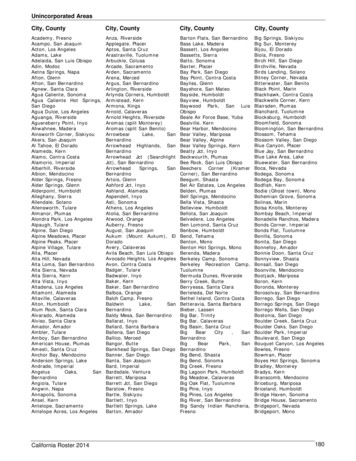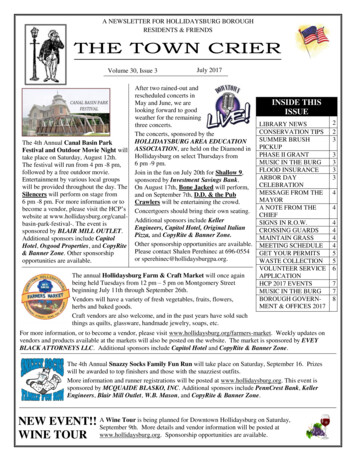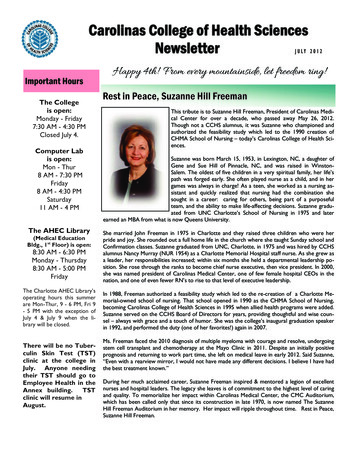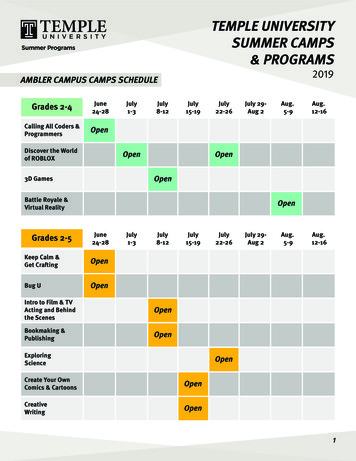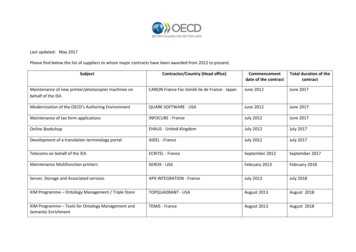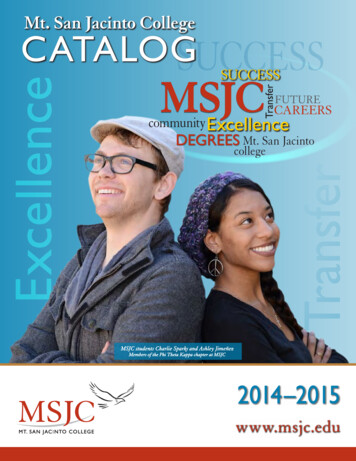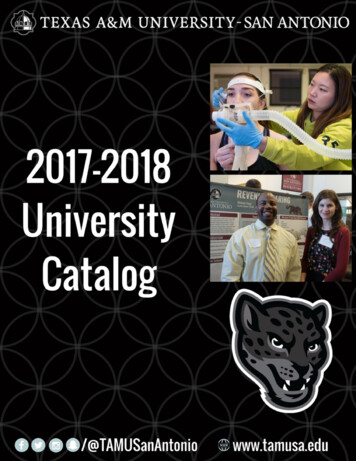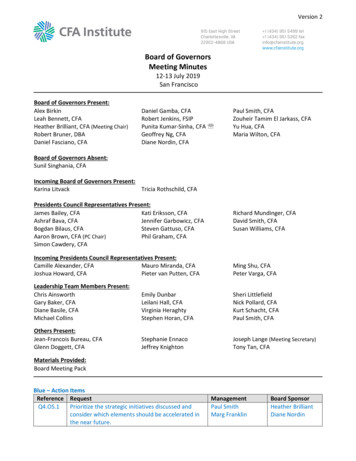
Transcription
Version 2Board of GovernorsMeeting Minutes12-13 July 2019San FranciscoBoard of Governors Present:Alex BirkinLeah Bennett, CFAHeather Brilliant, CFA (Meeting Chair)Robert Bruner, DBADaniel Fasciano, CFADaniel Gamba, CFARobert Jenkins, FSIPPunita Kumar-Sinha, CFA Geoffrey Ng, CFADiane Nordin, CFAPaul Smith, CFAZouheir Tamim El Jarkass, CFAYu Hua, CFAMaria Wilton, CFABoard of Governors Absent:Sunil Singhania, CFAIncoming Board of Governors Present:Karina LitvackTricia Rothschild, CFAPresidents Council Representatives Present:James Bailey, CFAKati Eriksson, CFAAshraf Bava, CFAJennifer Garbowicz, CFASteven Gattuso, CFABogdan Bilaus, CFAPhil Graham, CFAAaron Brown, CFA (PC Chair)Simon Cawdery, CFARichard Mundinger, CFADavid Smith, CFASusan Williams, CFAIncoming Presidents Council Representatives Present:Camille Alexander, CFAMauro Miranda, CFAJoshua Howard, CFAPieter van Putten, CFAMing Shu, CFAPeter Varga, CFALeadership Team Members Present:Chris AinsworthGary Baker, CFADiane Basile, CFAMichael CollinsEmily DunbarLeilani Hall, CFAVirginia HeraghtyStephen Horan, CFASheri LittlefieldNick Pollard, CFAKurt Schacht, CFAPaul Smith, CFAOthers Present:Jean-Francois Bureau, CFAGlenn Doggett, CFAStephanie EnnacoJeffrey KnightonJoseph Lange (Meeting Secretary)Tony Tan, CFAMaterials Provided:Board Meeting PackBlue – Action ItemsReference RequestQ4.OS.1Prioritize the strategic initiatives discussed andconsider which elements should be accelerated inthe near future.ManagementPaul SmithMarg FranklinBoard SponsorHeather BrilliantDiane Nordin
Board of Governors Meeting12-13 July 2019Reference RequestQ4.OS.2CSC Chair was asked to share the committee’s listof lessons learned regarding the CEO search withthe Board before the next succession planningprocess.ManagementChris AinsworthBoard SponsorDiane NordinGreen – Approved ResolutionsRed – Tabled ResolutionsFRIDAY, 12 JULYOPENING REMARKS AND PROCEDURAL MATTERSPresenter: Heather Brilliant, Board of Governors ChairMs. Kumar-Sinha attended via video conference call.The Board Chair welcomed everyone to the meeting in San Francisco. A brief overview of the agenda wasprovided, and the group was notified that the sessions would be recorded. The governors were asked todisclose any conflicts of interest as they pertained to the agenda. None were reported.Since the May meeting, the organization had announced the next CEO as Margaret Franklin, CFA. The Boardcongratulated and thanked the CEO Search Committee members for their efforts.CONSENT APPROVAL AND INFORMATIONAL MATTERSPresenter: Heather Brilliant, Board of Governors ChairMs. Kumar-Sinha attended via video conference call.The following resolutions were approved unanimously:RESOLVED, that the Board of Governors accepts and approves the appointment of the followingindividuals to serve as Board committee and council chairs and co-chairs for a one-year term commencing 1September 2019 and until their successors are chosen and qualified:Audit and Risk CommitteeInvestment CommitteeSociety Partnership Advisory CouncilChair:Chair:Co-Chair:Daniel Gamba, CFADan Fasciano, CFALeah Bennett, CFARESOLVED, that the Board of Governors accepts and approves the appointment of the followingindividuals to serve as Board committee and council members for terms commencing 1 September 2019 anduntil their successors are chosen and qualified.Chair:Members:Audit and Risk CommitteeDaniel Gamba, CFAGeoffrey Ng, CFATricia Rothschild, CFAYu Hua, CFARobert Bruner, DBAExecutive CommitteeDiane Nordin, CFADaniel Gamba, CFAHeather Brilliant, CFAMargaret Franklin, CFA2Compensation CommitteeMaria Wilton, CFAHeather Brilliant, CFADiane Nordin, CFADaniel Gamba, CFA
Board of Governors Meeting12-13 July 2019Chair:Members:Investment CommitteeDan Fasciano, CFAPunita Kumar-Sinha, CFARichard Mundinger, CFAGary Baker, CFABob Dannhauser, CFANominating CommitteeHeather Brilliant, CFADiane Nordin, CFAZouheir Tamim El Jarkass, CFAAlex BirkinSusan Williams, CFALamees Al-Baharna, CFADavid Smith, CFASociety Partnership Advisory CouncilLeah Bennett (Co-Chair)Karina LitvackAaron Brown, CFA (Co-Chair)Jennifer Garbowicz, CFABogdan Bilaus, CFARESOLVED, that Heather Brilliant, CFA, is authorized to vote on the behalf of CFA Institute as the soleVoting Member of the Research Foundation at its annual meeting of members;FURTHER RESOLVED, that Heather Brilliant, CFA, is authorized to vote for the approval of Joanne Hill,PhD, to serve as Vice-Chair of the CFA Institute Research Foundation Board of Trustees for a two-year termcommencing 1 September 2019;FURTHER RESOLVED, that Heather Brilliant, CFA, is authorized to vote for the approval of LottaMoberg, PhD, CFA; Dave Uduanu, CFA; and Joachim Klement, CFP, CFA, to serve as Elected Trustees of theCFA Institute Research Foundation Board of Trustees for a three-year term commencing 1 September 2019;FURTHER RESOLVED, that Heather Brilliant, CFA, is authorized to vote for the approval of RogerIbbotson, PhD, to serve as an Emeritus Trustee of the CFA Institute Research Foundation Board of Trusteesfor a three-year term commencing 1 September 2019; andFURTHER RESOLVED, that Heather Brilliant, CFA, is authorized to vote on such other matters that maybe presented at the above noted meeting, and to waive any notice of meeting requirements.RESOLVED, that the Board of Governors appoints Heather Brilliant, CFA, to serve in place of the Chairof CFA Institute as the Ex Officio Trustee of the Research Foundation assuming all responsibilities and dutiesof that position through fiscal year 2020.RESOLVED, that pursuant to Article 6, section 6.6(a)(ii) of the CFA Institute Bylaws, Joseph Lange isappointed to serve as Secretary for a one-year term commencing 1 September 2019 and until his successor ischosen and qualified.RESOLVED, that the Board of Governors for CFA Institute expresses its most sincere appreciation toRobert Jenkins, FSIP, and Sunil Singhania, CFA, for outstanding leadership, significant sacrifice of time andeffort, and exemplary spirit of dedication and purpose in advancing the profession during their terms asgovernors on the CFA Institute Board.RESOLVED, that the Board of Governors for CFA Institute expresses its most sincere appreciation toJames Bailey, CFA; Kati Eriksson, CFA; Philip Graham, CFA; Simon Cawdery, CFA; and Steven Gattuso, CFA,for outstanding leadership, significant sacrifice of time and effort, and exemplary spirit of dedication andpurpose in advancing the profession during their terms as Presidents Council Representatives.The following resolution was tabled:RESOLVED, that pursuant to Article 6, section 6.6(a)(ii) of the CFA Institute Bylaws, Diane Basile, CFA,is appointed to serve as Chief Financial Officer for a one-year term commencing 1 September 2019 and untilher successor is chosen and qualified.3
Board of Governors Meeting12-13 July 2019CHIEF EXECUTIVE OFFICER (CEO) REPORTPresenter: Paul Smith, President and CEO at CFA InstituteMs. Kumar-Sinha attended via video conference call.The CEO shared that he had recently met with the incoming CEO in New York to initiate the transition process.He stated that Ms. Franklin would be prepared to take over the role on 2 September and that he had heardnothing but positive feedback from the organization’s stakeholders since the public announcement.The CEO took a moment to thank his leadership team for all their hard work and support and indicated thatthere would be four major areas of focus for the incoming CEO. First, the Board would need to coalescearound the vision for Credentialing 2030 to ensure that the curriculum remained relevant going forward.Second, there needed to be a stronger relationship between the Board and leadership team to increase theorganization’s ability to execute. Third, there needed to be a bigger emphasis on culture. Fourth, theconversations around Societies 2.0 needed to continue to help local communities fulfill the mission. Lastly, itwas noted that the positioning of the mandatory Continuing Professional Development campaign would likelydetermine its success or failure, and there would need to be leadership from governors, PCRs, society leaders,and management.Since the last meeting, the organization had continued to develop its IT platform, had administered asuccessful June exam to 250,000 people in 400 test centers in 165 countries, made great progress in theproduct management world, shown a positive brand campaign impact on the high net worth populations inthe US and Canada, and developed an FY2020 operating plan and budget for the Board’s consideration.The CEO believed that the organization’s reserves could be managed more effectively and advocated usingsome of these funds to generate more impact at the local level and show CFA Institute as the leader of theinvestment profession.Management had followed the activities of other credentialing organizations as a means of establishing anexternal benchmark for best in class professional bodies. The CEO stated that a better framework for doing somight be needed to help the organization stay relevant and competitive.The CFA Program was popular largely due to its status as a globally recognized credential, but the organizationwas unsure what actions changed the rate of candidate registrations. Based on some studies, the bestexplanation seemed to be that growth had been directly related to GDP growth. It had also become apparentthat the prominence of the credential had been increasing in the emerging markets and waning in the US andCanada. This could pose a long-term risk to the organization, but initiatives like Credentialing 2030 andSocieties 2.0 could help to address some of those concerns.It was stated that the organization had look at diversification of revenue by region. The CEO stated that 30% ofthe world’s young would be in Africa in 20 to 30 years’ time, and that he anticipated a CFA Institute officethere in the next five years or so to start securing that pipeline of revenue.The Board wanted to empower the CEO and leadership team to bring forward more aggressive budgetproposals and ideas and would reflect on how best to do that.4
Board of Governors Meeting12-13 July 2019CHIEF FINANCIAL OFFICER (CFO) REPORTPresenters: Diane Basile, Chief Financial Officer at CFA InstituteJeffrey Knighton, Controller at CFA InstituteMs. Kumar-Sinha attended via video conference call.It was explained that Mr. Knighton had served has Controller at CFA Institute for the past two years and wouldbe serving as the Interim CFO after Ms. Basile’s departure. Mr. Knighton introduced himself to the group.The organization had experienced another successful year with registrations up 12% year over year andrevenue growing 14% year over year. It was reported that 52% of the new Level I population and 48% of theoverall exam population had consisted of Chinese passport holders.It was highlighted that the new systems would help the finance team complete its requirements for not-forprofit reporting and 606 revenue recognition. In addition, the purchase order system had been helping thefinance team manage vendors and expenses. These subjects had been discussed with the Audit and RiskCommittee the day prior.It was clarified that from the beginning of FY2013 to present day, Investment Foundations had reportedapproximately 10 million in revenue and 12 million in direct costs. The NetSuite platform had been helpingthe finance team better identify these direct costs and track which ones should be allocated. It was furtherstated that the number of people accessing the curriculum, which was now offered free of charge, hadincreased to 35,000 in the last year. The Board applauded this return on mission.The finance team had been working very closely with legal to catalog the current list of vendors to bettermonitor them in terms of the organization’s standard compliance matters.The contingency reserve and its related metrics had given the organization visibility into how it couldimmediately reduce costs at any given point in time. The finance team had also partnered with humanresources to better understand the headcount and the employee commitments in place.It was confirmed that disruptions associated with continuing professional development and Credentialing 2030would be taken into account in terms of budget forecasting.ADVOCACY REPORTPresenter: Kurt Schacht, Managing Director of Standards at CFA InstituteMs. Kumar-Sinha attended via video conference call.A brief history of advocacy at CFA Institute was provided. It was clear that the organization had come a longway to build market integrity through advocacy. There were four primary areas of focus: policy advocacy andregulator engagement, thought leadership and industry engagement, ethics and practitioner engagement, andinvestor education and public engagement. The first area would be the most significant in terms of creating abolder voice for CFA Institute and would require a more effective and sustained delivery of the organization’spolicy views as well as increased engagement from the societies.The Board was reminded of the three policy advocacy principles: to advance and promote policies that serveinvestor protection over commercial interests; to create content and advance policy research that improvesmarket structure, transparency, and fairness for all investors; and, to support the creation and adoption ofrules and regulatory standards which improve and expand investment industry professionalism.5
Board of Governors Meeting12-13 July 2019It was explained that to influence other industry stakeholders, professional associations, and policy makers, anorganization needed to first select the right topics and then create and distribute the right content. CFAInstitute used societies, expert staff, and volunteer committees, all of whom had varying perspectives, to helpscope and frame the organization’s advocacy policy focus. Despite the differences in opinion, the three guidingprinciples had returned people to the primary objectives, which did not include commercial interests.A litmus test, which incorporated 32 different elements, was then used to screen down all the advocacy topicsinto a workable project. The universe of advocacy topics considered was screened from the European Unionand the US, because these locations had a centralized system of industry regulations and oversight, aroundSeptember and October every year. These issues were then plotted on a graph based on their relevance to CFAInstitute and the organization’s ability to influence the thinking or outcome on the subject. Input was solicitedfrom societies, expert staff, and volunteer committees to address regional differences, and the four or fivemost important potentially impactful themes in capital markets and the financial reporting area were selected,resulting in an overall top 10 list. As part of the next phase of work, the organization would endeavor toprovide tools and tactics to societies interested in addressing other advocacy topics outside of the top 10.It was reaffirmed that the top 10 priority list was representative of the societies. The regional society advocacycouncils had provided a great deal of input and had created a better marriage between the individual societypriorities and the organization’s priorities.It was stated that the three principles would guide the organization to meet high level requirements ofinvestor protection, market integrity, transparency, and professionalism regardless of the impact on thecommercial interests of the membership or where a subject might fall on the partisan scale. It was noted thatthe materials had included a set of advocacy success metrics, which had been in line with what many otherthink tanks used to measure impact. In terms of influence and impact, the organization had gained credibilityfor calling out commercial interests that were being disguised as protections.It was explained that while the research and policy content creation pieces had a more thoughtful, longer termapproach, the organization could react quickly to breaking items in the press, such as regulation best interest,mis-selling value for money, etc.The organization’s stance on ESG had been that analysts should incorporate it if it was considered a materialfactor. It was not a mandate.The group was reminded that policy advocacy would be discussed at the Board retreat in September.FY2020-FY2022 STRATEGY PLAN WORKSHOPPresenters: Diane Basile, Chief Financial Officer at CFA InstituteStephen Horan, Managing Director of Credentialing at CFA InstituteMs. Kumar-Sinha attended via video conference call.The governors, PCRs, and members of the leadership team were broken into six representative teams todiscuss the strategy behind the three strategic pillars: Develop Future Professionals, Deliver Member Value,and Build Market Integrity. Each team was asked to address the following questions: Does CFA Institute have the right initiatives in place to achieve the mission?Are these initiatives being prioritized appropriately?Does CFA Institute have the capabilities and capacity to deliver them?Where does CFA Institute hope to be 1,2,3 years from now?6
Board of Governors Meeting12-13 July 2019Develop Future Professionals Overall, CFA Institute had the right initiatives in place with three core items underway: the learningecosystem, computer-based testing (CBT), and continuing professional development (CPD). 100% market penetration could be achieved outside of the charter (i.e. special certificates) with a bindingethics component. The charter could be delivered differently in the future, potentially through modularization and/or thirdparty (i.e. societies, current competitors) input. Credentialing 2030 would help address the growingsegmentation of the investment management field, but there was a question as to whether the bar wasbeing set high enough for the CFA Program. There should be a formalized initiative to accelerate the learning ecosystem work, specifically theinstitutional relationships to increase penetration of the core and the relevance of the charter andspecialist certificates. CFA Institute could leverage societies to achieve this pillar by sourcing content from them for the learningplatform. Societies could leverage CFA Institute to achieve this pillar by partnering with them to develop institutionalrelationships and sharing specialist certificates launched at the local level for wider distribution to otherparts of the world. The mission was to serve the profession, and the group recognized that the profession had been changing.The CFA Program had been geared toward security analysts, portfolio managers, and private wealthadvisors, but should also include other rising fields, such as private equity and Fintech, and consider thegrowing importance of soft skills. Professional development should be defined as more than just the mastery of objective knowledge, andthe organization’s CPD program should be flexible enough to serve its constituents by including moreexperiential learning (i.e. wisdom) and local relevance (i.e. programs developed by societies). Virtualcommunities could be leveraged to connect people for higher learning opportunities (i.e. mentoring withexperts). The organization would soon need to achieve clarity of content and create a documented plan toward apositive vote for mandatory CPD.Deliver Member Value The transition from candidate to member (i.e. from CFA Institute to a local society) needed to be asmoother and more positive experience. It was suggested that Level III candidates have a societyconnection to ensure integration and better job opportunities after receiving the charter. It was noted that member satisfaction had been low around career management and brand of the charter. CFA Institute was not a technology firm but needed to be technology enabled. Technology should providea seamless foundation for CPD, a closed network for professional connections, and be integrated with thesocieties. The CPD framework needed to clearly map an individual’s career path through the various jobs and skillsets required. The organization had the capacity and funding to achieve its initiatives but there needed to be a clearvision of how technology and CPD were going to enhance member satisfaction. The necessary resourcesshould then follow to accomplish that vision. The development of soft skills to help members secure more opportunities at the C-suite level wasemphasized. There was a question whether this should be in the CPD framework, the curriculum, or both. There was a question as to whether the organization put enough emphasis on the career portal andwhether it was achieving its intended results. It was recognized that there were many organic overlaps between the three strategic pillars.7
Board of Governors Meeting12-13 July 2019Building Market Integrity Advocacy had created significant opportunities for networking and professional development and gaveCFA Institute a strong and credible voice to strengthen its brand. If the desire was to lead the professionand be a champion for investors, the organization might need to be more courageous in this area. The organization might need to consider different initiatives for the developed vs. emerging markets in thefuture. There was great value in asking local people what the initiatives should be to facilitate ideageneration, but there was still an important role at the CFA Institute level in terms of oversight andcoordination. The organization could allocate more funding towards the emerging markets for a biggerreturn on mission (i.e. regulators approaching local societies). CFA Institute had the depth and length of tenure to organize introductions and create a network in thelocal markets. If justified (i.e. high ultimate impact), more resources could be allocated toward theorganization’s capacity to deepen relationships with the societies to deliver on building market integrity. Leveraging the membership database could lead to strong advocates for CFA Institute and societies in theindustry. It was acknowledged, however, that member participation could be constrained by the laws,regulations, and social/political climate within their country of residence. Looking ahead, the group advocated for a more balanced partnership between CFA Institute and thesocieties to empower societies to take more ownership of building market integrity in their local marketswherever possible. In the future, the group wanted regulators to view CFA Institute as the voice of integrity and asset ownersand pension trustees to approach CFA Institute for training. There was also a desire to increase the noncharterholder membership population as this could be used as a measure of success.As part of the concluding comments, the Board agreed that it would be important to prioritize the strategicinitiatives discussed and consider which elements should be accelerated in the near future.Q4.OS.1SATURDAY, 13 JULYPROPOSED FY2020 BUDGET AND OPERATING PLANPresenters: Diane Basile, Chief Financial Officer at CFA InstituteJeffrey Knighton, Controller at CFA InstituteMs. Kumar-Sinha attended via video conference call.The FY2020 budget had been structured to ensure that the organization was being responsible in terms ofgrowing expenses less than revenue. Revenue had been projected to be around 11% and gross expensesaround 10%, inclusive of the standalone 5 million fund. A visual display showed the group how revenue hadbeen forecasted for Level I, Level I, and Level III candidates and how this would change beginning in FY2021with the introduction of computer-based testing (CBT). It was noted that the organization had already beenworking on modeling budgets beyond FY2021, but that there were still some uncertainties, including pricingand the overall timeline of the exam process from registration to results. There was some discussion on theknown and potential changes in revenues and expenses associated with CBT. In the short-term, CBT wouldcause expenses to rise but would ultimately be cost-effective over the longer-term.It was explained that a fund of 5 million, which had not been allocated to any specific function or region, hadbeen included in the budget. The purpose was to provide the incoming CEO with some flexibility given thenumber of multi-year projects underway, with an emphasis on continuing professional development (CPD) andCBT. The fund had been intentionally separated out from the main budget for reasons of full transparency. The8
Board of Governors Meeting12-13 July 2019Board understood and encouraged management to come forward if additional resources were needed duringthe fiscal year.It was clarified that the organization would eventually be able to produce quarterly forecasts with hardmonthly closings. This would give management an accurate snapshot of the budget at any given point in theyear and allow them to reallocate funds accordingly. In addition, the organization had been building thecapacity to systematically report out on Level I, Level II, and Level II expenses. This would better support thebusiness and fulfill some of the requirement changes occurring in the not-for-profit world.The group was reminded that all projects at CFA Institute were cross-functional.The credential had been a differentiating factor in times of economic downturn. Historically, registrationswould plateau upon crisis and bounce back afterward. The organization had learned from these instances aswell as from GDP growth metrics and developed a sensitivity analysis around the credentialing revenues. Thisanalysis was formally conducted twice a year and accounted for both variable and fixed costs.The organization had been keeping track of the CBT budget but would not be able to provide an accurateforecast until it had a grasp of the pricing policy and revenue side for candidates. The proposed budget hadbeen built on current assumptions, and there were tools in place to monitor the numbers and help with thevariance analysis piece.It was explained that a review of the contingent workforce was underway and that the results would be sharedwith the Audit and Risk Committee and Compensation Committee.The IT budget had included best estimates for the exhaustive list of ongoing projects, and it was noted that thedepartment had yet to reach a “business as usual” threshold.The Board made it clear that they were open to an increased headcount or more aggressive action plan andencouraged management to approach them with these types of requests for consideration throughout theyear.The following resolution was approved unanimously:RESOLVED, that the Board of Governors accepts and approves the proposed FY2020 budgetsubstantially in the form submitted.PROMINENT CODE AND STANDARDS CONSIDERATIONSPresenters: Tony Tan, Co-Head of Ethics, Standards, and Professional Conduct at CFA InstituteJean-Francois Bureau, Standards of Practice Council ChairGlenn Doggett, Director of Professional Standards at CFA InstituteMs. Kumar-Sinha attended via video conference call.The presenters introduced themselves to the group. It was explained that there were four elements neededfor the organization’s codes and standards to be considered best in class: structure and independence, moralauthority, a governance foundation, and aspirational standards. The first two elements had been met by CFAInstitute, but the third and fourth needed to be revisited to ensure that the codes and standards referencedglobal regulations and had a “future-ready” perspective.The Standards of Practice Council (SPC), which consisted of 15 volunteer members worldwide, had beensoliciting feedback from external consultants, staff, and the Disciplinary Review Committee (DRC), and wouldultimately release their proposals for public comment. These inputs would all be used when considering any9
Board of Governors Meeting12-13 July 2019potential changes to the codes and standards, and the final recommendations would be presented to theBoard for approval. It was clarified that the SPC was responsible for writing the code, the Professional Conduct(PC) team was responsible for building cases based on that code, and the DRC was responsible for reviewingcases and rendering a verdict.The SPC had reached out to legal academics in the US from Georgetown University of Law, in the UK fromUniversity College of London Law School, and in Singapore from the National University of Singapore and gavethem a broad remit to review the codes and standards against the laws in their respective markets. All threehad reported that the codes and standards had met or exceeded many of the expectations within theirrespective markets but had also provided clear examples of where regulations might be changing. Thisfeedback had been shared with the DRC and PC.The codes and standards had typically be aligned with US law but would likely become more stringent with theproposed changes. The SPC believed that this was necessary to maintain the gold standard in the industryaround the world. To attain these higher standards, the SPC would be addressing conflicts of interest, servicesand fees, competence, vulnerable investors, and ethical culture.The governors would discuss Board involvement with regards to the work on the codes and standards duringexecutive session and report back to management.NOMINATING COMMITTEE / AWARDS STRATEGYPresenter: Robert Jenkins, Nominating Committee ChairMs. Kumar-Sinha attended via video conference call.The Board was briefed on the recent activities of the Nominating Committee (NC).NominationsThe group was reminded that one of the remits of the NC was to build a balanced Board in terms of desiredsize and mix of skill sets. The NC would provide recommendations and look to the Board to provide ultimatedirection and guidance.An overview of the skill set matrices for FY2020, FY2021, and FY2022 was provided to highlight certain areas offocus. It was noted th
consider which elements should be accelerated in the near future. Paul Smith Marg Franklin . Heather Brilliant . CFA; and Joachim Klement, CFP, CFA, to serve as Elected Trustees of the CFA Institute Research Foundation Board of Trustees for a three-year term commencing 1 September 2019; . The CFA Program was popular largely due to its .
